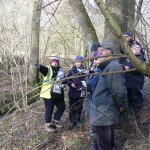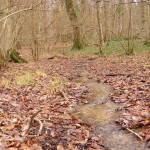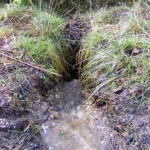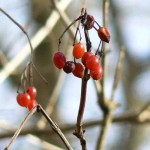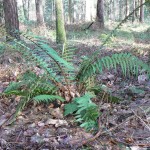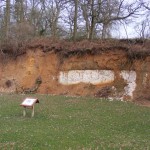On Saturday 8th February, Lesley Dunlop led a geology walk at Bradfield, starting from the Black Barn at Rushall Manor Farm. Following 2 months of heavy rain, there were flood alerts on many of the local rivers and the resulting road closures had made the journey to Bradfield challenging for some of the attendees. Before starting out on the walk, the group looked across the bright green fields on the Chalk, laid down about 85 million years ago, to the woods on the other side of the River Pang, which are on the Reading Beds of sands and clays and were laid down about 60 million years ago. The walk started out up through Rushall Copse on the Reading Beds. The recent heavy rain helped to emphasise the different layers. Springs formed at the bottom of the sandy layers and rapidly turned into fast-flowing streams as they cut their way down through gulleys in the clay. At the edge of the wood, a significant stream ended in a pool with no obvious exit. The water vanished down a hidden sinkhole, leaving no trace on the Chalk field below the wood. Continuing up the track through the woods, there were still waxy red berries on a Guelder-rose bush. Leaf rosettes of Primroses and new leaf spikes of Bluebells were well developed, and Wood Spurge and Bugle were noted. The track climbed up to the London Clay layer at the top of the woods, which was laid down about 50 million years ago. The clays of the Reading Beds are redder and contain more iron than the London Clay. The London Clay was laid down in a marine environment, while the Reading Beds were laid down in estuarine conditions.
The route then crossed Scratchface Lane and followed a footpath across a sticky field on the London Clay. It entered a section of wood called The Gravels, and almost immediately became drier underfoot, with bracken growing at the side of the path. The gravel layer would have been laid down about 500,000 years ago by outwash from ice sheets to the north. Holes, plus a latrine at the side of the track, indicated recent Badger activity. Tall green clumps of Scaly Male Fern in the woods beside the track marked the move back onto the London Clay. Woodruff appeared at the side of the track soon after it dropped back down onto the Reading Beds. Lesley’s eagle eye picked out a quartz pebble amongst the flint gravel on the bank at the side of the track. It would have come originally from the volcanic rocks of Cornwall or Brittany, formed 295 million years ago, before being carried to the Bunter Beds in the Midlands. From there, it would have been brought by glacial outwash to its current location. Bright green leaves of Wood-sorrel were seen on a sandy layer of the Reading Beds in the appropriately-named Sorrel Copse. The route then led out of the woods and crossed the edge of an arable field, before dropping down to the Owl Pit chalk quarry. The exposed face of the quarry has a thick white Chalk layer at the bottom. The top of the Chalk would have been eroded for about 30 million years, before being covered by a thin dark layer containing the mineral glauconite, which is laid down in marine environments. Above are thick orange layers of sand and thinner grey layers of clay from the Reading Beds.
Pictures by Rob Stallard and Laurie Haseler

